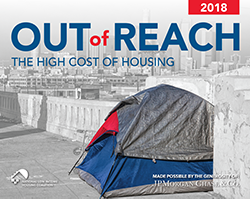 NLIHC released Out of Reach: The High Cost of Housing 2018 on June 13. The report compares rents and wages nationally and in every state, country, and city in the U.S. Out of Reach 2018 shows that both average renter wages and prevailing minimum wages are insufficient to afford modest rental apartments throughout the country, and the disparity is severe for those with the lowest incomes.
NLIHC released Out of Reach: The High Cost of Housing 2018 on June 13. The report compares rents and wages nationally and in every state, country, and city in the U.S. Out of Reach 2018 shows that both average renter wages and prevailing minimum wages are insufficient to afford modest rental apartments throughout the country, and the disparity is severe for those with the lowest incomes.
The report’s Housing Wage is the hourly wage a full-time worker must earn to afford a modest rental home while spending no more than 30% of his or her income on rent and utilities. In 2018, the national two-bedroom Housing Wage is $22.10 per hour. A household must have an annual income of at least $45,960 to afford a two-bedroom rental home at HUD’s average fair-market rent of $1,149 per month. The average hourly wage of renters in the U.S. is $16.88, $5.22 less than the two-bedroom Housing Wage.
The federal minimum wage is $14.85 less than the two-bedroom Housing Wage. A full-time minimum wage earner would have to work approximately 122 hours per week for 52 weeks a year to afford a two-bedroom apartment, or 99 hours per week to afford a one-bedroom apartment at fair-market rent. In no state, metropolitan area, or county can a worker earning the federal minimum wage or prevailing state minimum wage afford a decent two-bedroom rental home at fair market rent by working a standard 40-hour week. There are just 22 counties out of more than 3,000 counties nationally where a full-time minimum-wage worker can afford a one-bedroom apartment at fair-market rent.
Among states, the two-bedroom Housing Wage ranges from $13.84 in Arkansas to $36.13 in Hawaii. Hawaii, California, New York, and the District of Columbia all have a Housing Wage of $30 per hour or higher. Seventeen states and the District of Columbia have a Housing Wage higher than $20 per hour. The five metropolitan areas with the highest two-bedroom Housing Wages are Stamford-Norwalk, CT ($38.19), Honolulu, HI ($39.06), Oakland-Fremont, CA ($44.79), San Jose-Sunnyvale-Santa Clara, CA ($48.50), and San Francisco, CA ($60.02).
Seven of the ten occupations expected to add the most jobs in the next ten years provide a median wage that is lower than the two-bedroom and one-bedroom Housing Wages. The occupation with the greatest projected growth, personal care aids, is expected to increase by more than 770,000 jobs in the next decade. The median hourly wage of personal care workers is $11.32, or $6.58 less than the one-bedroom Housing Wage of $17.90. Five hundred and eighty thousand food preparation jobs are expected to be added in the next ten years. Food preparation jobs pay a median hourly wage of $9.89, which is $8.01 less than the one-bedroom Housing Wage.
The lowest income renters have the greatest challenge finding affordable housing. The national average fair market rent for a one-bedroom home is $931 per month and $1,149 for a two-bedroom home, far higher than the maximum $660 per month that an extremely low income family can afford. Seventy-one percent of extremely low income renter households are severely housing cost-burdened, meaning they spend more than half of their incomes on housing, leaving few resources for other necessities and putting them at risk of losing their homes.
The findings in Out of Reach 2018 demonstrate the large disparity between the incomes of low-wage workers and other vulnerable populations and the cost of modest rental homes. To address this disparity, NLIHC calls on lawmakers to increase federal funding for key affordable housing programs like Housing Choice Vouchers, the national Housing Trust Fund, public housing, and project-based rental assistance. These critical programs serve as a safety net and provide stable, affordable homes for the lowest income households.
The Out of Reach 2018 interactive website, which also includes an easy-to-use search function for Out of Reach data by metropolitan-area ZIP codes, is at: https://bit.ly/1JCBH0s
The full Out of Reach 2018 report as available at: https://bit.ly/2M1LHIB